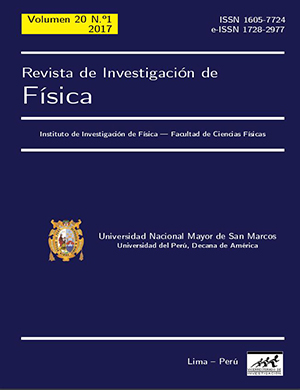Physical processes controlling the exchange of water between the Puno Bay and the Main Basin of Lake Titicaca, in Peru.
DOI:
https://doi.org/10.15381/rif.v20i1.14709Keywords:
Barotropic waves, baroclinic, diffusion, residence timeAbstract
Lake Titicaca, at present, is considered a natural wonder of the world. It is the habitat of many unique and endangered native species, with flora and fauna of great diversity, site of nesting of many migratory birds, source of fresh filtered water, by its volume, regulates the air temperature of the region allowing climate conditions less aggressive for life. However, in the last decades, the anthropogenic influence affected its conservation. The problems that Lake Titicaca presents are concentrated in the littoral zone, the bays and the Lake Minor. Large quantities of wastewater that enter directly or poorly treated, in particular to the Bays of Puno and Copacabana, are generating eutrophication processes. The effect of the discharges are the increase of sediments accumulated in the bottom, explosive flowering of Lemna sp. algae on the surface, reduction in dissolved oxygen levels, and decrease in water quality. However, pollution processes cannot be understood only in terms of the organic matter load that they receive, since they are well coupled to a wide range of physical processes that will link the dynamics between the littoral zone and the main basin. It has been shown in large lakes, which move nutrients, heat, organic carbon, and other tracers through isobars, from the edge of the lake to the inner shelf, and vice-versa. These physical processes largely determine the average time in which pollutants remain in areas near the coast and, therefore, it is necessary to estimate their concentration and the level of variability in the coastal zone. In regions with strong exchange, nutrient flows through the coastal zone still appear to be dominated by large water intakes, and there is little evidence of anthropogenic disturbance. In areas of restricted exchange, in turn, there is strong evidence of human impact, in terms of the amount of phytoplankton and relative abundance of species, or deep areas of the lake where oxygen decreases. The coastal zone of Lake Titicaca, and in particular, the Interior Bay of Puno, is a paradigmatic example of pollution caused by human action without control over the environment close to the coast. The Interior Bay is linked to the Outer Bay of Puno by two channels and a region with a lot of totora that generates restrictions to the exchange. Unfortunately, little is known about the type of exchange or the physical processes that control the ow of substances between the Bay of Puno and the main body of the lake. This is also the case of many bays in lakes around the world, in which the exchange processes remain largely unexplored. Therefore, there is an urgent need to understand the physical processes that control the exchange between coastal and pelagic zone, this would allow bettering treating water quality problems in coastal areas. Our objective is to understand the physical mechanisms that intervene in the exchange of water and substances between coastal and pelagic zones in large tropical lakes. We use the Bay of Puno and the Big Lake, as an example of the case. We estimate the flow of exit or entry through the mouth of the Bay of Puno, due to three physical processes that we consider of greater importance that would be responsible for the flow of water and substances. In particular, attention is paid to horizontal exchange driven by barotropic waves, baroclinics and diffusion processes, issues that are currently not explored. To fulfill this objective, a combination of scale arguments is used, based on existing field data that appeared mainly in scientic and professional reports, and simulations that were carried out with a three-dimensional hydrodynamic transport model and, originally developed by the Geological Survey Service. United States, at the University of California, Davis, USA, expanded and adapted at the University of Granada to run in parallel architectures. The exchange rates and residence time of the Bay of Puno were estimated, as well as the diusion rate for a substance, between the Big Lake and the Bay of Puno. Keywords: Barotropic waves, baroclinic, diusion, residence time.Downloads
Published
Issue
Section
License
Copyright (c) 2017 César Aguirre

This work is licensed under a Creative Commons Attribution-NonCommercial-ShareAlike 4.0 International License.
THE AUTHORS RETAIN THEIR RIGHTS:
a. The authors retain their trademark and patent rights, as well as any process or procedure described in the article.
b. The authors retain the right to share, copy, distribute, perform and publicly communicate the article published in the Revista de Investigación de Física (for example, place it in an institutional repository or publish it in a book), with an acknowledgment of its initial publication in the Revista de Investigación de Física.
c. The authors retain the right to make a subsequent publication of their work, to use the article or any part of it (for example: a compilation of their works, notes for conferences, thesis, or for a book), provided that they indicate the source. of publication (authors of the work, journal, volume, number and date).






